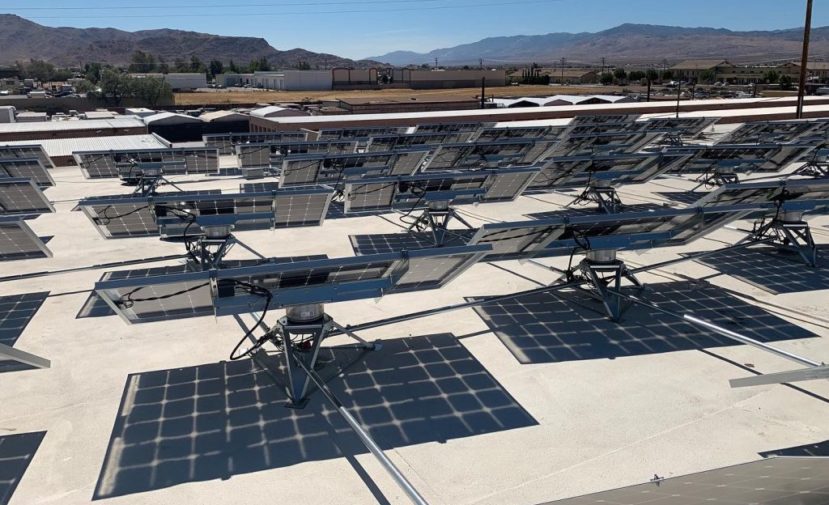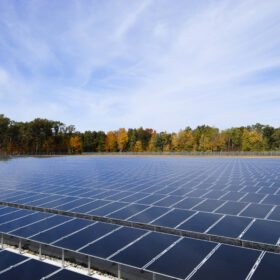It’s not a stretch to say that the world of utility-scale solar development is run by trackers. By upping a project’s capacity factor, trackers allow modules to generate more power, allowing for less modules to be used in a project and overall lower overhead costs.
As successful as trackers have been in the utility space, that dominance has not applied to residential and commercial and industrial (C&I) projects. Traditional tracking systems have been inviable for these applications, mainly due to their weight and susceptibility to damage from high winds.
Seeing opportunity in this untapped market, startup Point Load Power has launched its PV Booster, a tracking system designed for commercial applications. It’s this undefended hill of small-scale project tracking that Point Load Power CEO and co-founder Peter Ciulla sees as the path to success.
“The first-generation PV Booster tracker was conceptualized by Bill Gross at the Idealab incubator back in 2016,” Ciulla told pv magazine. “The goal there was to take those economic benefits of tracking that had been proven year after year in utility-scale PV projects and bring them to the growing C&I market.”
Using a steel frame and low-profile design, the product has achieved UL 3703 certification, as well as the wind loading requirements of ASCE 7-16, achievements that Ciulla asserts the company spent all of 2019 working toward.
“Weight and wind. The way we solve those is keeping things short and keeping it as small and as low to the roof deck as possible… These small, short trackers end up keeping those wind loads as low as possible, which keeps the weight as low as possible and ultimately transfers lower loads onto the building structure.
Ciulla also believes that success will come with the lower project overhead costs that its product creates by reducing the number of panels needed to reach certain levels of generation.The company claims that, when paired with bifacial modules, PV Booster trackers can up the power per panel of a project by 70%, compared to an ordinary, 5 degree, fixed-tilt, monofacial system.
“You can do more with less,” Ciulla said. “That 70% more energy means 70% more revenue and that enables projects to use just about half the number of modules and receive 40% greater return on investment for their projects.”
The 70% more energy per panel claim has been proven, at least once, in the field — it comes from an installation of PV Booster trackers on a 20 kW Option One Solar installation in Apple Valley, California. In this instance, the building is aligned perfectly North-South and the true figure is 68% more power per panel.
It is also a claim questioned by resident commercial solar guy, John Weaver, who thinks the increased energy output figures are more complex than advertised.
“You do get more electricity from each solar module, that’s great,” Weaver shared. “But you can fit a lot fewer solar modules up there. So the total rooftop electricity increase, well, we don’t know that number yet. Will we generate more electricity from the roof? With the price of solar modules so cheap, does it makes sense to optimize for their usage by adding moving parts?”
Because of their travel, PV Booster trackers take up more space per module than traditional racking.
Point Load has raised funding from Alumni Ventures Group, Bascom Ventures, General Sheet Metal Works, and Idealab, according to Pitchbook.
This content is protected by copyright and may not be reused. If you want to cooperate with us and would like to reuse some of our content, please contact: editors@pv-magazine.com.









Installing a tracker adds 70% more while buying a second panel system of the same size adds 100% more and costs less to build and keep maintained. If you want longer power day, just aim one third of the panels 22.5 degress east by south east and one third of the panels 22.5 degrees West by south west if you live in the northern hemesphere with one third just south ./\__/\__/\__/\ Power from sunup to sundown without the expense of tracking systems that need servicing, can be damaged in storms or vandelized. Although trackers look cool, there initial cost would be better spent on additional panels just placed at different angles now that Solar panels cost only 20% of what they cost 10 years ago. This is for both on-grid non battery systems and off-grid battery based systems. MPPT battery based system work very well if 40% to 50% of the panels face East by south East because the batteries want to fast charging first thing in the morning after a night long draining of stored power from the previouse day and less in the afternoon when batteries can not take as fast a charge for the top off for the last 20%. Grid tied systems want more power after 12:00 noon because that is when air conditioners come on line and evening meals are cooked in the afternoon. Tracking systems give you the same power all day and may not meet your systems time of day needs.as adding more panels.
A major benefit is not just more power but longer power, 8 peak hrs instead of 5.
And all that comes early and late in the day covering a bunch of the duck cutting the need for batteries.
Though with more panels with them facing half more east and half more west and with peak sun, they should be angled to give max inverter power could do as good or better.
Looks good for big roofs with small loads. Curious of how much extra cost this adds.
Edward Dijeau is right, adding complexity to the elegant simplicity of solar PV could be considered an exercise in insanity. Researching the system products before specifying any components is tantamount to success over decades of use. Another article here suggests the company Q cells has the best solar PV technology available to remediate or lessen the typical solar panel degradation issues like LID and PID. This product has a 25 year (linear) performance warranty and can be found for around $225 per panel a $0.70/watt cost. A 100Kwp system on a large roof would cost $70.43K, one could space the panels like Edward Dijeau has proposed above or can increase the amount of panels on the roof to a D.C. to A.C. ratio of 1.3 to 1 and install $91.4K of panels to allow ‘clipping’ of the D.C. buss for more reliable power each day. With a 1.3 to 1 ratio you have a system ready for future energy storage. Even Point Load Power’s web site says Use 50% less panels and get 70% more generation per panel. Yeah, that’s great, but what does their roof solar PV tracker cost per panel? The above Q cell example, I found online for $225 for a 320 watt panel $0.70/watt. IF you bought 406 of these panels could you get the cost down to $0.65/watt? How about %0.55/watt?
For years, solar PV trackers have been offered and in several cases, operations failures actually over time decrease the “effectiveness” in solar harvest. An old timer solar PV installer once told me, he had replaced a relatively large system with trackers on poles, with ground mount solar PV racking and added 20% more solar PV panels to make the system more reliable with the same output. The Engineering adage KISS really applies here for that robust decades of operation system everyone wants.
I imagine one day the solar PV tariffs will run out, solar PV panel prices will come down and we might see solar PV panels at the retail $0.50/watt price point. Even for their home systems, it may become common for a home owner who has the roof space to put in 12kWp to 16kWp systems to power their homes off of the sun for most of the day. Energy storage is also coming down in price, having a large energy storage system with a large solar PV array will allow the home owner to self consume solar generation for 10, 12 maybe 16 hours a day. Yeah, the sun doesn’t shine at night, with the right system in place it doesn’t have to.
Sorry to be a dissenter, but this configuration has about as much practicality as solar roadways.
1) Those modules are just ready to fly off that roof, structurally attaching a single module this way would require much stronger base.
2) The initial installation price of these trackers will far exceed putting up more pv modules in a static array.
3) These small trackers have high maintenance and poor reliability over the long term.
I see no practicality or viability for the masses. There may be niche application for those with deep pockets that are intent on maximizing kWh per square foot, but only with much stronger (and more expensive) mounting.
2d trackers usually claim, at most, a 40% increase in production compared to fixed tilt installs, and even that is a stretch because early and late in the day, many trackers will have to back track to avoid shade from other trackers. I have no idea how these folks come up with a 70% increase in production for their system.
They ignore the effects of clouds. On a cloudy day, the extra cost and complexity of tracking the sun buys you nothing. You have to count only the fraction of days which are not cloudy when computing the benefit of tracking. It varies from site to site. Death Valley is better than Chicago.
Also, my own computations do not support their 70% claim. A program I wrote to compute this had figures less than half of that, comparing a driven panel to a fixed panel whose normal points to the celestial equator. So they must be comparing it to a less favorable case.
Interesting, would you say that the above orientation suggested by Edward Dijeau, perhaps using bifacial solar PV panels and using snow white roof paint to help enhance back and side solar PV harvest a more sensible option for a large solar PV roof?